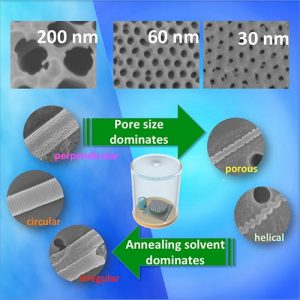 Block copolymers, which contain two or more polymer blocks, have been largely studied over the past decades because of their abilities to self-assemble into various nanostructures, which can be applied to fields such as nanolithography, photovoltaics, and drug delivery.
Block copolymers, which contain two or more polymer blocks, have been largely studied over the past decades because of their abilities to self-assemble into various nanostructures, which can be applied to fields such as nanolithography, photovoltaics, and drug delivery.
Although ordered arrays with areal densities in excess of 10 terabits per square inch have been fabricated using block copolymer thin films, the achievable density is limited by the two-dimensional nature of the thin films. To overcome such limitations, many progresses have been reported on the fabrication of three-dimensional block copolymer nanostructures.
Recently, the research group led by Prof. Jiun-Tai Chen at National Chiao Tung University in Taiwan developed a novel SAINT (solvent-annealing-induced nanowetting in templates) method to fabricate three-dimensional block copolymer nanostructures. The unique advantage of this method is that the problem of thermal degradation can be avoided and the lengths of the nanostructures can be well controlled.
In their recent publication in Macromolecular Chemistry and Physics, they use anodic aluminum oxide membranes with different pore sizes as templates to investigate the competition between the effects of annealing solvents and pore sizes on the morphology manipulation of block copolymer nanostructures.
At larger pore sizes, the morphologies of the block copolymer nanostructures are mainly determined by the annealing solvents. When the pore sizes become smaller, the confinement effect dominates and the morphologies of the block copolymer nanostructures are controlled by the pore sizes. The polymer chains are compressed or stretched to compensate the incommensurability between the domain spacing and the pore size.
The results demonstrate that the morphologies of three-dimensional block copolymers can be tuned by changing either the annealing solvents or the pore sizes of the porous templates, offering more flexibility and variety to the applications using block copolymer nanostructures. In this work, many interesting morphologies have been obtained, including helical, porous, circular, perpendicular, and irregular morphologies.
In the future, the researchers at National Chiao Tung University will implement this strategy to construct ordered arrays of three-dimensional nanostructures and study their applications in data storage or optical devices.
















